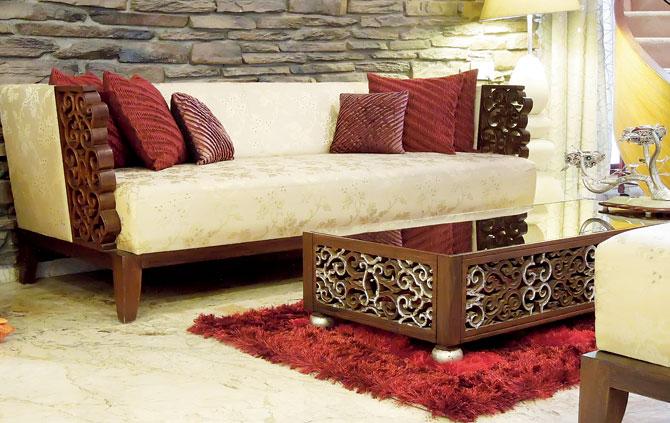As the monsoon draws close, we get experts to suggest different ways to ensure that every corner of your home, from artworks and furniture to your walls, gadgets and appliances, stays rain-proof

Mumbai Household
Artworks
Canvas: Always hang your canvas on a dry wall. Some people use an artwork to hide moisture or cracks on walls, try avoiding that, as it is actually detrimental to your artwork. Avoid installing art where there is a significant change in temperature; for example, near balconies, as it might cause expansion and contraction of art and lead to cracks. Due to the moisture content in cracks, fungus starts to grow in them. If you notice fungus growing, immediately clean it gently with a cotton swab or an ear bud. Don’t use chemicals or any kind of detergent on the cotton. If not, call an expert, as you might need to get it restored.
ADVERTISEMENT

PIC/Nimesh Dave
Print: When you hang an art print, always ensure that it is laminated in matte plastic, known as matte lamination; this also works for posters i.e. media is printed on a thin paper. Sometimes, due to the moisture content in the air, the paper of the artwork starts warping, and ripples are observed around the poster/art work. If matte lamination of the artwork isn’t possible, mount the artwork with a clear float glass as a covering to avoid exposure to moisture. It is always recommended to keep a de-humidifier, with expensive artwork installations. Place rubber spacers or buffers behind frames. This way, the frame will always be a little away from the wall and prevent moisture from getting trapped behind it. While storing paintings and frames, keep sachets of silica gel with it. This will help keep moisture at bay.
 Pic courtesy/ Tanmay Mukherjee Architects
Pic courtesy/ Tanmay Mukherjee Architects
Upholstery
Composite leather: Generally tougher, and more moisture-friendly than genuine leather, clean your leather sofas with a slightly damp cloth to remove any kind of fungal growth. Post that a second sweep with a dry cloth is recommended.

Pic courtesy/ The Fuchsia Lane
Genuine leather: Extra care needs to be taken. Apply natural oils to avoid a change in colour of the sofa. Most of the premium companies which provide genuine leather sofa also provide a natural kit /solution with which you must wipe and clean your leather products. Never intentionally dry your leather sofa’s with hand dryers; these will cause ripples as the skin of the leather always expands and contracts on a fast rate when subjected to high heat. Use leather conditioners that are easily available in the market, every couple of months, to take care of and protect your leather pieces. A home remedy to clean moulds and mildew requires a very small quantity of diluted White Vinegar (many modern air-conditioners have built-in de-humidifiers with separate controllers). Apply about one portion vinegar to three portions of water. However, it is wise to try on a small patch of leather first.

Pic courtesy/ The Fuchsia Lane
Fabrics
Silk/other valuable apparel
These must be aired regularly, dry cleaned and stored in a dry place. Upholstery with different fabrics is usually sprayed with 3Mscotchgard, which is a protective spray. Companies can be appointed on annual maintenance contract basis to spray your fabrics prior to the monsoon so that it can fight moisture.
>> Replace heavy curtains and upholstery with light and airy fabrics.
>> Slip-covers are a good option.
>> Remove rugs and carpets and store them away for the season.
Furniture
Wooden: Everyday cleaning is required. If you have old Burma teak wood, maintenance is less since the wood is old and has already been subjected to several cycles of rains, hence it is less problematic. However, other type of wood will require a protective coating of wax, clear varnish, matt melamine spray, or clear coat of lacquer to avoid the change in the colour of the wood. Most wooden doors and shutters are made of block board ply, which are subjected to expansion as they absorb moisture in the rainy season. That’s why, at times, doors and cupboards are slightly difficult to open, often making a sound or brushing against the floor. People apply laminate/veneer on both sides of doors but must ensure that the border lining of the door, which is exposed, is sprayed with polish/waxed/ painted in a similar colour of the veneer/laminate. This offers protection on all four sides. Always place silica gel sachets in the cupboard, to keep the interiors relatively dry. Change your stockpile of clothes repeatedly and place camphor balls to avoid infestation.
Laminated: An extra coat of finishing spray should do the trick; don’t expose laminated furniture to direct rains, constant cleaning with a sponge and cloth is the best solution. Don’t use scrubs to clean the surfaces as it may lead to scratches and also crack open the protective layer of the coat, making it vulnerable to moisture. Precautionary measures can be taken at construction stage of wardrobes or drawers. A few more tips to keep in mind:
>> Ensure all cross grain edges of wood, plywood and other such materials are covered.
>> High-quality water resistant binding materials must be used to make long lasting furniture.
>> Protective coatings like lacquer and melamine are available in the market.
Interiors
False Ceilings: A false ceiling is made of gypsum powder/Plaster of Paris. The inherent material is a moisture absorbing menace that quickly sucks in moisture and allows fungal growth on it. The problem with a false ceiling is that the GAP between the false ceiling and the RCC slab is never ventilated and when prone to moisture, it attracts fungal growth, as it is always wet in nature. Keep windows open, and your apartment airy, but the gap in the false ceiling is never ventilated. Try to ventilate the gap in the false ceiling with a blower. This can be done by removing one of the concealed light fittings and using that opening to exhaust the condensed moisture ridden air. The paint quality used in ceilings is also important; people generally put ordinary plastic, flat oil paints for false ceilings, instead special paints that are readily available, must be considered.
Wallpaper: Try and use wallpapers on internal walls, as external walls may be prone to moisture seepage. Wallpapers are maintained with a dampened cloth or swabbed with a very mild detergent. Supposedly, if there are bubbles caused during rainy season, it means there is an air lock formed between the plastered surface and the wallpaper. In such a situation, call the vendor who will introduce a pinhole needle to vent out the air, and replace it with a special chemical such as adhesive.
Painted walls: The biggest foe of a painted wall is fungal growth. Whenever one observes a fungal growth on a wall, it, usually is an external wall that faces the building periphery or a wall, which carries the plumbing lines of the bathroom. This is because there is always moisture in the walls due to constant lashing of rains on the outer facade of the building. Besides cleaning your walls regularly, always ensure that the quality of paint applied on the walls is superior. A mistake that people tend to make is that they immediately open the doors and windows, post switching off the air conditioner. Due to this sudden change of moisture and temperature, condensation begins, and we notice water droplets on painted walls, and they appear wet all the time.

Plants
>> All plants should be trimmed if required before monsoon as they can be destroyed with the wind. Similarly, small shrubs need to be securely tied.
>> Ensure sufficient drainage, and clean decaying leaves
>> Make sure you take your indoor plants out on a sunny day in this season.
>> Having too many indoor plants is not a good idea in the monsoons as it increases dampness due to their transpiration process. Good quality artificial plants can be an option.
Information courtesy: Tanmay Mukherjee, Tanmay Mukherjee Architects & Pooja Malhotra and Gopika Parekh, The Fuchsia Lane
Kitchen
Equipment
>> Regular maintenance of any equipment.
>> All moving parts of equipment like fan belts in coolers should be greased well to avoid friction and corrosion.
>> Defrosting of fridges is a must as more moisture in the air leads to ice formation on compressors.
Food products
>> All dry products to be kept in air -tight containers as well as away from any water source to avoid moisture as much as
possible
>> Raw meat products must be kept in cool temperature, below 4 degree C. Spoilage rate is higher in the monsoon.
>> During this season, check supplies tcarefully, because a lot of fresh vegetables might carry worms and insects (broccoli, lettuce, cauliflower).
Information courtesy: Paraag Nayak, Sous Chef, Terttulia, Shivaji Park.
 Subscribe today by clicking the link and stay updated with the latest news!" Click here!
Subscribe today by clicking the link and stay updated with the latest news!" Click here!






